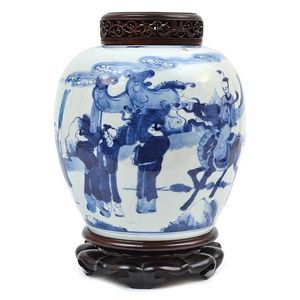Antique Chinese Porcelain Ginger Jar with 'Prunus' Pattern
You must be a subscriber, and be logged in to view price and dealer details.
Subscribe Now to view actual auction price for this item
When you subscribe, you have the option of setting the currency in which to display prices to $Au, $US, $NZ or Stg.
- Qing Dynasty - The Qing Dynasty was the last imperial dynasty of China, ruling from 1644 to 1912. It was established by the Manchu people, who originated from the northeastern region of China. The Qing Dynasty was preceded by the Ming Dynasty and followed by the Republic of China.
- Ming Dynasty - The Ming Dynasty was a ruling dynasty of China from 1368 to 1644. It succeeded the Yuan Dynasty and preceded the Qing Dynasty. The Ming Dynasty was established by Zhu Yuanzhang, a former Buddhist monk who became a rebel leader and eventually overthrew the Mongol Yuan Dynasty. During the Ming Dynasty, China experienced a period of relative stability and prosperity. The government was centralized and bureaucratic, with the emperor at the top of the hierarchy. The Ming Dynasty is known for its cultural achievements, including the development of porcelain, the invention of movable type printing, and the construction of the Great Wall of China.
- Chinese Cracked Ice Motif - The Chinese cracked ice decorative motif is a traditional design that was commonly used in Chinese art and architecture, particularly in the Ming and Qing dynasties (1368-1912). The motif is characterized by a pattern of small, irregular cracks or fissures that resemble broken ice.
The cracked ice motif was often used in a variety of decorative arts, such as pottery, porcelain, lacquerware, and furniture. It was also used in architectural elements, such as floor tiles, roof tiles, and wall panels. The motif was typically created by carving or incising the surface of the material, and then filling the cracks with a contrasting color, such as black or gold.
The cracked ice motif symbolizes the idea of "coolness" in Chinese culture, and was often used in architectural elements to create a sense of coolness and shade, especially in hot climates. In decorative arts, it is considered as an elegant and refined design that evokes the natural beauty of ice.
This item has been included into following indexes:
- Chinese ceramics, dynasty mark or period - Guangxu mark 347
-
Chinese ceramics, item type
- ginger jars 235
- pot pourri and jars 1,357
Visually similar items

A large and finely painted Chinese blue and white jar, Kangxi, 17th century, emblem mark in double circles to base, 30 cm high, wood cover and stand 33 cm high overall

A blue and white ginger jar with wooden cover and stand Kangxi period / 18th century, decorated with figurative scenes, double ring mark to base hairline and firing flaw the vase, 21.5 cm high

A blue and white Swatow 'dragon' jar late Ming dynasty, stoutly potted of baluster form, painted with a dragon encircling the sides above a band of waves, with a frieze of rocks and flowers at the base, the shoulders with a ruyi scroll and set with four lu

Chinese blue and white ginger jar, possibly Kangxi period, lozenge symbol to the base, with wood lid and stand. Height 13 cm
